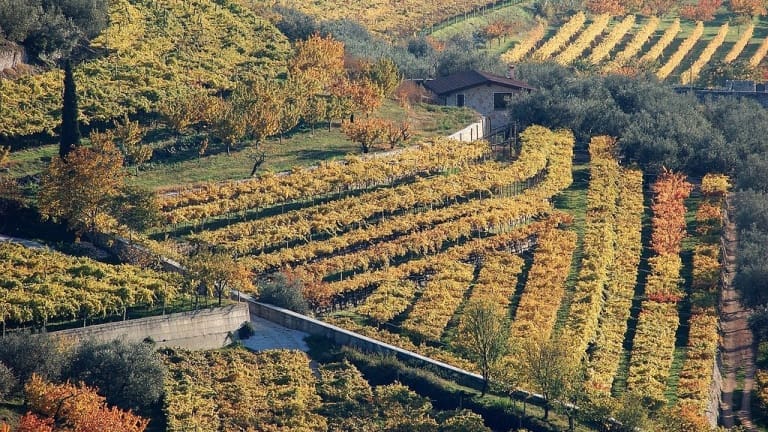
Region: Veneto

Wine from the Veneto region exemplifies the culture and heritage of winemaking in Italy. The Veneto region continues to be one of the most important wine-producing regions in Italy, with an expected output of about 8.18 million hl of wine in 2022. The majority of the wine produced in this region is white, and approximately thirty percent of it is awarded the DOCG or DOC designation.
The most generally planted red grape variety in Veneto is Merlot, while the most widely cultivated white grape type is Prosecco, followed by the indigenous Garganega. The varieties of red berries known as Corvina, Rondinella, and Molinara are quite popular, particularly in the Verona and Vicenza regions. The province of Verona is famed for producing some of the region’s greatest DOCG wines, including Soave Superiore, Bardolino Superiore, Amarone della Valpollicella, Recioto della Valpollicella, and Recioto di Soave, a delightful raisin wine created from Garganega grapes. Torcolato is an additional dessert wine that is well worth mentioning. It is created in the Breganze region of Italy from Vespaiola grapes.
The region of Valpollicella is renowned for producing powerful and fragrant red wines, such as the world-famous DOCG Amarone della Valpollicella, which is prepared from partially dried Corvina, Rondinella, and other local grapes in addition to other local grape varieties. The Berici Hills are home to the one-of-a-kind red Friulano grape variety, which is most commonly grown around Barbarano and results in the production of a red wine that is crisp and full of fruit flavors.
Friularo is a full-bodied red wine that is made from a biotype of Raboso Piave grapes. It is included in the Bagnoli DOC, which is known for producing the DOCG Colli Euganei Fior d’Arancio. The Euganean Hills are famed for producing this wine, which is made from Yellow Muscat grapes.
Prosecco-Treviso
The hills in the higher portion of Treviso are mostly used for the production of Prosecco, which is then used to make several distinct kinds of Conegliano-Valdobbiadene, with Extra Dry being the most popular of these. Because of its exquisitely fragrant attributes, the Prosecco Valdobbiadene-Superiore of Cartizze, which is made in the same limited region of San Pietro di Barbozza, is famous around the world. In these regions, sweet wines like as Torchiato di Fregona and Refrontolo Passito da Marzemino are produced. Torchiato di Fregona is created from Prosecco and Verdiso grapes, and Passito da Marzemino is made from Marzemino grapes.
Although international grape varieties such as Pinot Grigio, Chardonnay, Pinot Bianco, Merlot, Cabernet Franc, and Cabernet Sauvignon are popular in the eastern areas of Veneto and in Friuli-Venezia Giulia, local grape varieties such as Friulano, Verduzzo Trevigiano, and Raboso Piave also occupy a significant portion of the vineyard.
Soave
The region surrounding the town of Soave, which is located close to Verona, is where the world-famous Soave wine is made. Soave is widely considered to be one of the best wines produced in the Veneto region. Garganega is the grape that is used to make Soave wine, which is famous for its reputation for being minerally, fresh, and crisp. The vineyards in the Soave producing zone have soils that are exceptionally high in volcanic minerals, which gives the wine a personality all its own. The volcanic soils are made up of basalt and tuff, both of which are abundant in minerals like as magnesium, iron, and potassium. These minerals contribute to the production of wine that has a strong structure and is well-balanced. Because of the unique soils and the high-quality grapes that are grown here, the wines that are made in this region have a complex flavor profile and an excellent acidity. This is due to the fact that the grapes planted here are of such high quality. The highest level of accreditation that can be achieved for Italian wines is known as the Denominazione di Origine Controllata e Garantita (DOCG) classification, which has been awarded to the Soave wines that are produced in this region.
History
During the time of the Romans, the area was known as Venetia, which was derived from the name of the ancient people that originally inhabited the territory. This area was also known as Venice Euganea, a name that always descended from the ancient people who lived there (the Euganei), who were later assimilated by the Venetians. The Euganean Venice, together with Venezia Tridentina and Venezia Giulia, is one of the three cities that make up the so-called “Tre Venezie.” The Venetians arrived in the area around the year 1000 B.C., and they were followed by the Etruscans and the Reti-Arusmati between the seventh and fifth centuries BC. As a result of the meeting of their agricultural practices, the first steps toward the production of wine were taken, and they were successful in some cases. The Roman conquest brought about an improvement in conditions and elevated the reputation of the wine produced in the Rhaetian region, particularly that of the Euganean and Vicentine hills and Mariziale.
Catajo Castle: Veneto’s Enchanted Palace Among the Euganean Hills
Marostica 2024: A Venetian Gem’s Guide to Chess, Culture, and Cherries
Mel in 2023: Explore Italy’s Hidden Historical Gem in Valbelluna
Lake Garda’s Enchanting Gems: Explore the Most Picturesque Towns
Gargantuan Garganega: Soave Classico Vineyards of Foscarino Inama 2019
Bortolomiol Filanda Rosè Brut Millesimato 2020: A Perfect Valentine’s Day Wine – A Lovely Pink Juice
The Barmaster Gin Review And Tasting Notes
2009 Pietro Clementi Amarone Della Valpolicella: Review And Tasting Notes
Amarone Ca Dei Frati Pietro Dal Cero 2009 Review And Tasting Notes
Wine Dharma | ALL RIGHTS RESERVED | © 2021 | P.IVA 03392591206 | Credits